Ink in the lines: tattoo stories of our veterans
This is the fourth in a series of articles on the Memorial’s tattoo project and tattoo collections.
The Memorial’s Ink in the lines project is documenting the stories of servicemen and servicewomen through oral history interviews and portrait photography. The Memorial’s “tatt team” have been to Victoria, Queensland, and New South Wales, meeting some wonderful veterans who generously shared their time and their experiences. We are still receiving images and stories submitted via our online form.
Here are some of the stories and images that have been shared so far.
Elaine's story
Australian Army veteran Elaine deployed to East Timor in 2000. Her story is now part of the Memorial’s National Collection.
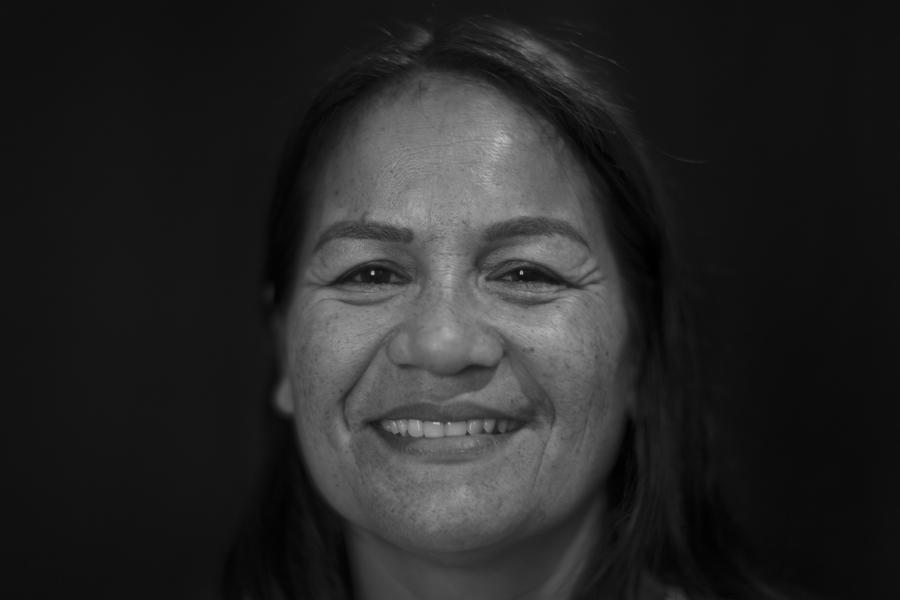
Portrait of Elaine for Ink in the lines
Elaine began acquiring her tattoos after her service. Her first tattoo is a tribute to her first Kokoda Track trek.
The first tattoo I got … it was when I was OK. I did Kokoda. So it’s the pillars of the courage, endurance, mateship, sacrifice.
She got her second tattoo – a large mandala –when she was “in a little bit of a dark state”, seeking the physical discomfort that a large tattoo would produce.
Elaine later realised she was ready to make some changes in her life.
So I said, “OK. Right, Elaine; new start now …” I started collecting what I wanted: ... My mum’s signature before she died ... The poppies ... represent my 13 years of service in the military. And I like mandalas because it’s another breath of life ... The snake represents the shedding of the skin ... It’s like, “Move on, Elaine!” ... People go, “Hey, I like your tattoo”, and I can tell a story, from start [at the wrist] to finish [at the shoulder].
The tattoos helped express the positive changes Elaine was making.
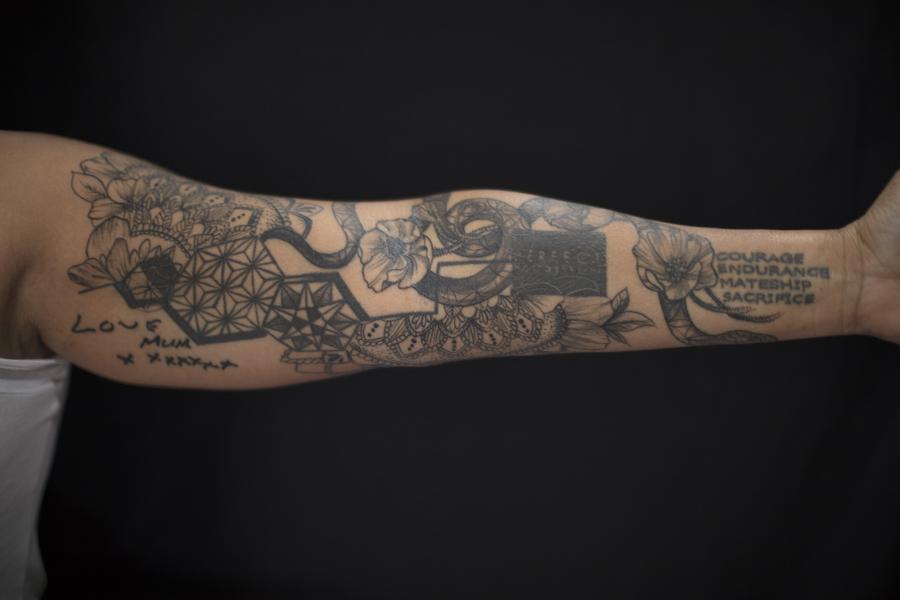
Elaine’s tattoos, although acquired at different times in her life, form a whole and coherent design.
I felt like when I had this, it felt like armour ... I feel like a Wonder Woman now ... A transformation’s just happened after the tattoo got put on ... And it’s like an armour for me to say, “Wow. There is life after. You can, you can recover. You just got to reach out and ask for help.”
Alex's story
Alex is an Army veteran of 22 years, and counts himself lucky to have deployed on four major campaigns occurring in those years. He has tattoos covering his left arm:
I wanted to get a sleeve ... I thought the two things that have been a major part of my life are my family, and my service. I’ve been in the Army now for more than half the time I’ve been alive, so it’s a fairly prominent part of my life. So I got the top half service-inspired, and the bottom half, family.
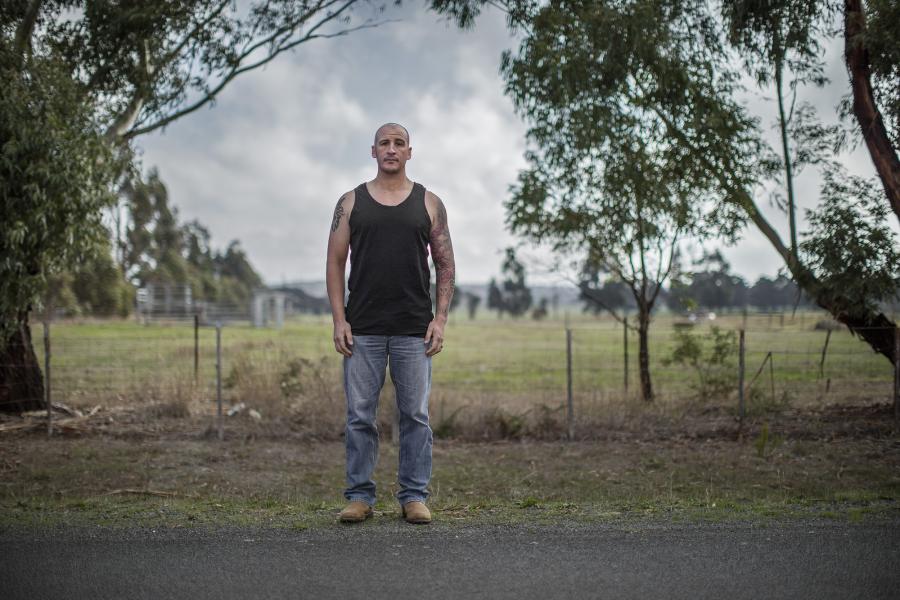
Alex photographed for Ink in the lines
Tattoo artist Glenn, who Alex counts as a friend and collaborator in the designs, gave him the Rising Sun emblem on his left shoulder, personalised with the names of areas Alex deployed to: Iraq, East Timor, and Sinai.
Basically just the Rising Sun, ‘cause that’s the Army. We wear that on all of our uniforms, in that same spot, so I got that there. Instead of “Australian Army” written in the scroll below, I decided to put the three deployments I’d had at the time.
But even the best designs can only go so far:
It’s actually funny. At the time Glenn goes, “Are you sure you want this there, ‘cause what if you deploy again?” I said, “I’m not going anywhere again, mate. I’m done”.
Sure enough, two years later, Afghanistan.

Glenn works on Alex’s sleeve
While there wasn’t room on the scroll for the word “Afghanistan”, Glenn represented the deployment with a design further down Alex’s sleeve and inner arm. As the Memorial team looked on, Glenn worked to complete the new design.
Today we’re going on with Afghanistan-type-inspired scene, with soldier in the foreground, mountains in the background and a couple of Blackhawks flying over the mountains, which is something that we saw, every day.
Alex would not highlight his own efforts overseas but reflected on the remarkable nature of Army life and work:
The friends you meet and the job you do, the things you experience. I don’t know any other job you can do those things ... And just being able to help, when you’re overseas, and hoping that it’s going to work out in the end. It’s a good sense of satisfaction … The thing I got from that was if you had a bar, the Australians set the bar high ... The professionalism in what we do is second to none.
Deb and Chris' story
Deb and Chris had their lives changed by their Navy service. Not only do they credit the Navy with making them who they are today, without the Navy they would never have met. Married since 1984, the pair shared the stories of their careers before and after marriage.
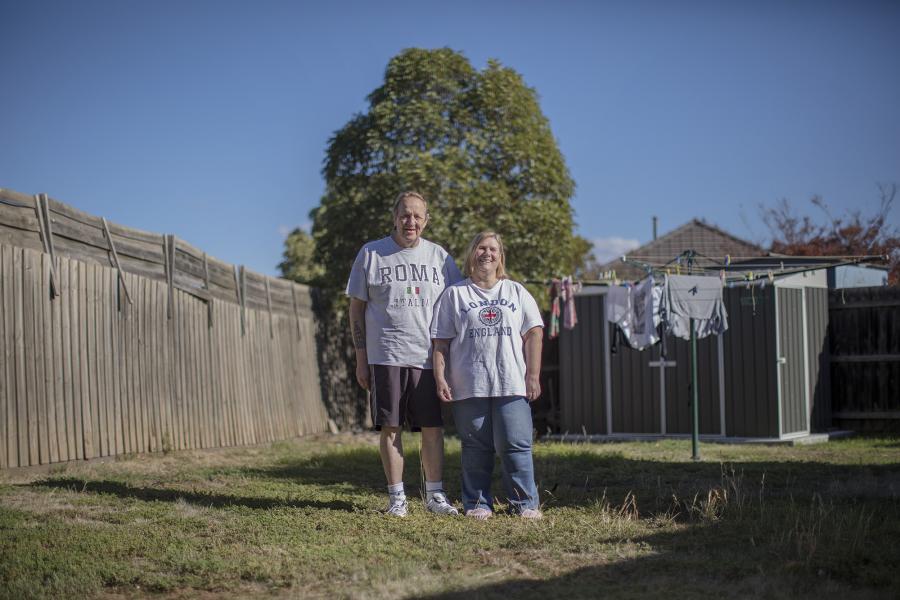
Deb and Chris photographed for Ink in the lines
For a young woman in the 1980s, the Navy could be intimidating. Females were expected to sit separately from males. Even men and women sitting together in the mess (the dining hall) was a new development.
Deb recalled:
My join up date was October 1980, so I was 19 ... Back in those days, females were kept separate from the guys ... It was only a couple of intakes before us that they started letting the guys eat with the girls in the same mess as recruits. And when we walked into the mess ... They had a separate area for us ... Everyone just turns and stares ... We’d been told not to talk to the guys. Walking into our sectioned-off area. That was our first day.
Deb credits the experience and others like it into helping make her who she is today.
We didn’t know anyone at all, but that’s what life in the Defence Force is; you get used to walking into situations where you don’t know anybody. And at that age that’s one of the hardest things I ever did. But looking back, that’s what it brought out of me.
Being a woman in the Navy could also be a challenge.
You were a female in a man’s world, a total man’s world. You either sank or swam ... a lot of females couldn’t handle it, but again this is where I say it changed me. I would stand up for myself ... and back then it just meant they would respect you a bit more.
The Navy not only helped Deb grow as a person, but provided a very special introduction.
We weren’t supposed to fraternise, but obviously we did. Chris and I met at Coonawarra ... 1983 ... We got married in October 1984.
Says Chris,
Back in the day, [if] you had tattoos, you were a sailor. And that’s how they identified you ... a lot of them would say, “now I’m a rough tough sailor”, but you’re not. Other guys went through Navy [for] 30 years, never got one ... I don’t think her parents liked me all that much!
Chris also experienced the Navy as a crucial factor in his personal growth.
I don’t know what Deb’s parents were like, but mine were really, really strict ... Growing up, I got a bit of a rough time ... [but] after being in the Navy for a while and going home, it changed. Pop had a lot of respect. And I learned to stand up for myself ... In the end we were good mates ... I knew myself after I’d been away for 12 months and then, age 17 – bright lights of Sydney – gee, this is the growing up experience pretty quick ... You soon get a good grasp of life ... You grow up pretty quick ‘cause if you don’t grow up, you won’t survive.
Chris has a tattoo in memory of his parents, and tattoos for his wife, Deb, and their two children. Other tattoos, such as this pair of mermaids acquired in San Francisco and in Los Angeles, are like passport stamps for the places he’s been with the Navy.
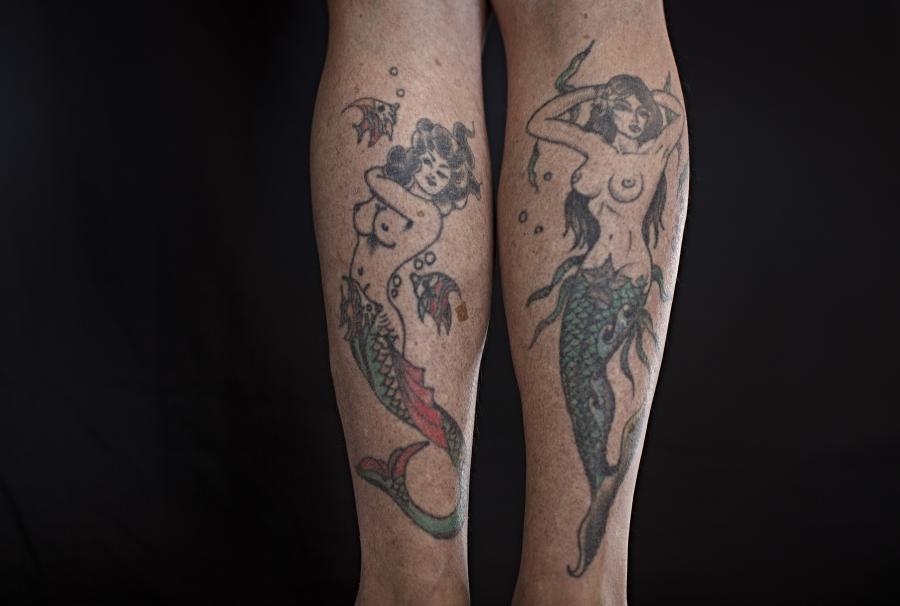
Chris’s mermaid tattoos
Mermaid is, to me, the sea; the sea side of it. A lot of blokes go with a ship, something like that, but for me, the mermaid is the sea, and travel.
Deb’s anchor tattoo is the symbolic embodiment of her experiences.
For me it represents my naval career, but the flowers represent the fact I was in a man’s world. A lot of people get the anchor to represent they’re stable. But for me it represents what I’ve been through ... a very important part of my life ... It was a great life. A great life. And I would do it all over again.
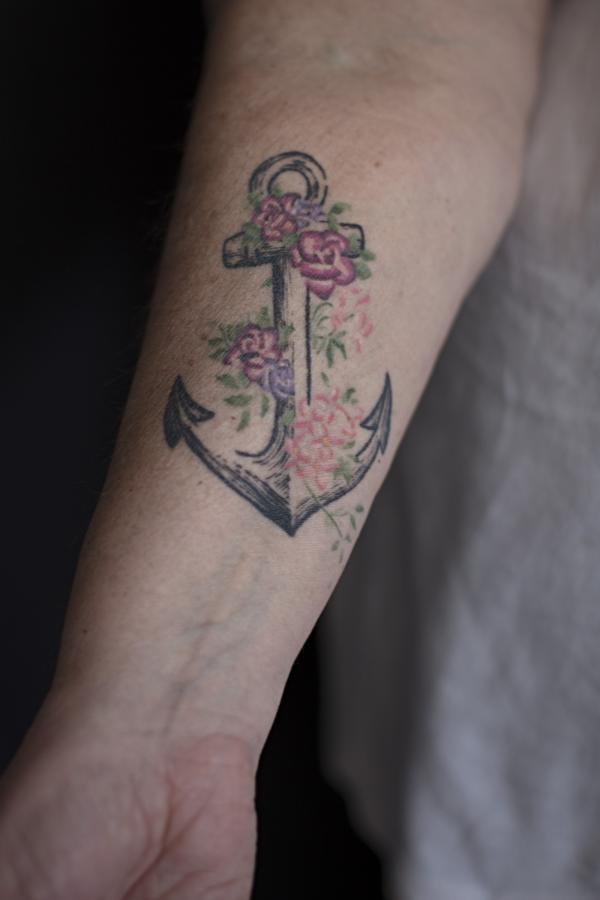
Deb’s anchor tattoo, a tribute to her years of Naval service.